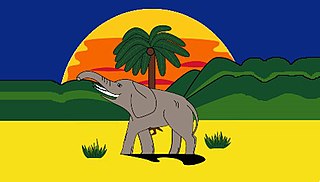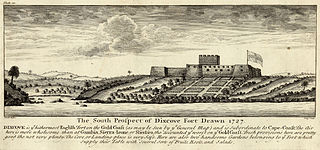Related Research Articles
Gold Coast may refer to:

Cape Coast Castle is one of about forty "slave castles", or large commercial forts, built on the Gold Coast of West Africa by European traders. It was originally a Portuguese "feitoria" or trading post, established in 1555, which they named Cabo Corso.

British West Africa was the collective name for British colonies in West Africa during the colonial period, either in the general geographical sense or the formal colonial administrative entity. British West Africa as a colonial entity was originally officially known as Colony of Sierra Leone and its Dependencies, then British West African Territories and finally British West African Settlements.

Swedish overseas colonies consisted of the overseas colonies controlled by Sweden. Sweden possessed overseas colonies from 1638 to 1663, in 1733 and from 1784 to 1878. Sweden possessed five colonies, four of which were short lived. The colonies spanned three continents: Africa, Asia and North America.
John Canoe, also known as January Conny, was the European name given to an Akan warrior from Axim, Ghana. He was a chief of the Ahanta people in the early 18th century, who established a stronghold in the defunct Fort Fredericksburg and fought multiple wars with European traders for twenty years. The stronghold finally fell in 1725, though Canoe's fate is unknown. He is commemorated in the Junkanoo festival held in the Caribbean each December.
Opperhoofd is a Dutch word that literally translates to "upper-head", meaning "supreme headman". The Danish equivalent overhoved, which is derived from a Danish pronunciation of the Dutch or Low German word, is also treated here.

The Dutch Gold Coast or Dutch Guinea, officially Dutch possessions on the Coast of Guinea was a portion of contemporary Ghana that was gradually colonized by the Dutch, beginning in 1612. The Dutch began trading in the area around 1598, joining the Portuguese which had a trading post there since the late 1400s. Eventually, the Dutch Gold Coast became the most important Dutch colony in West Africa after Fort Elmina was captured from the Portuguese in 1637, but fell into disarray after the abolition of the slave trade in the early 19th century. On 6 April 1872, the Dutch Gold Coast was, in accordance with the Anglo-Dutch Treaties of 1870–71, ceded to the United Kingdom.

The Danish Gold Coast comprised the colonies that Denmark–Norway controlled in Africa as a part of the Gold Coast, which is on the Gulf of Guinea. It was colonized by the Dano-Norwegian fleet, first under indirect rule by the Danish West India Company, later as a crown colony of the kingdom of Denmark-Norway.

The Brandenburger Gold Coast, later Prussian Gold Coast, was a part of the Gold Coast. The Brandenburg colony existed from 1682 to 1721, when King Frederick William I of Prussia sold it for 7,200 ducats and 12 Black slaves to the Dutch West India Company.

The Swedish Gold Coast was a colony of the Swedish Africa Company founded in 1650 by Hendrik Carloff on the Gulf of Guinea in present-day Ghana in Africa. Under foreign occupation for much of its existence, it disappeared for good in April 1663 when it became part of the Dutch Gold Coast.

Osu Castle is a castle located in Osu, Ghana on the coast of the Gulf of Guinea in Africa.

The Gold Coast was the name for a region on the Gulf of Guinea in West Africa that was rich in gold, petroleum, sweet crude oil and natural gas. This former region is now known as the country Ghana.

The Treaty of Axim was concluded between the Netherlands and the chiefs of Axim in the western region of the Gold Coast and signed at Fort St. Anthony near Axim on 17 February 1642. The treaty regulated the jurisdiction of the Netherlands and the Dutch West India Company in the town and polity of Axim after the Dutch West India Company had successfully attacked the Portuguese who were the occupants of Fort St. Anthony in the town. Over time, the agreement was in part superseded and replaced by new contracts and agreements. The treaty did remain the basis for Dutch jurisdiction and political relations between Axim and the Dutch until the latter left the Gold Coast in 1872.
Conrad Crull was the second governor of the Danish Gold Coast from 1674 to 1677. He governed the Danish Gold Coast from Fort Friedensburg (Frederiksborg).

Hendrik Carloff, Caerloff or Caarlof was an adventurer and slave trader active in the 17th century. Carloff began his career as a cabin boy but rose to become a commander and governor appointed by the Dutch West India Company and Danish or the Swedish Africa Company on the Gold Coast. Between 1676 and 1677, he was Governor of Tobago.

Fort Metal Cross, originally Fort Dixcove, is a military structure located on a promontory at the fishing community of Infuma in Dixcove, in the Western Region of Ghana. Because of its history in the Atlantic slave trade and its testimony to European-African trade, the Fort was included as one of the Forts and Castles of Volta, Greater Accra, Central and Western Regions that became a World Heritage Site in 1979.

Fort Apollonia is a fort in Beyin, Ghana. The name Apollonia was given to the area by a Portuguese explorer who sighted the place on the Feast of Saint Apollonia, 9 February. Because of its importance during the European colonial period and its testimony to the Atlantic slave trade, Fort Apollonia was inscribed on the UNESCO World Heritage List along with several other forts and castles in Ghana in 1979.
Erik Tylleman was an Opperhoved of the Danish Gold Coast, a Danish Crown Colony. He governed from the colony's capital, Fort Christiansborg. Tylleman was the first Danish Governor who reigned in the United Gold Coast in 1698. The Danish Gold Coast was established on the eastern Gold Coast.
References
- ↑ Danish: means Factor (agent); Factor, also rendered as Station Chief
- ↑ Ole Justesen, ed. Danish Sources for the History of Ghana 1657–1754 Vol. 1 (1657–1735). Copenhagen: The Royal Danish Academy of Sciences and Letters, 2005. p. 48 ISBN 87-7304-312-5
- ↑ The title of Governor was bestowed on three individuals before 1766: von Gronstein; Crull; and Prang.
- ↑ Closing the Books: Governor Edward Carstensen on Danish Guinea, 1842–50. Translated from the Danish by Tove Storsveen. Accra, Ghana: Sub-Saharan Publishers, 2010.